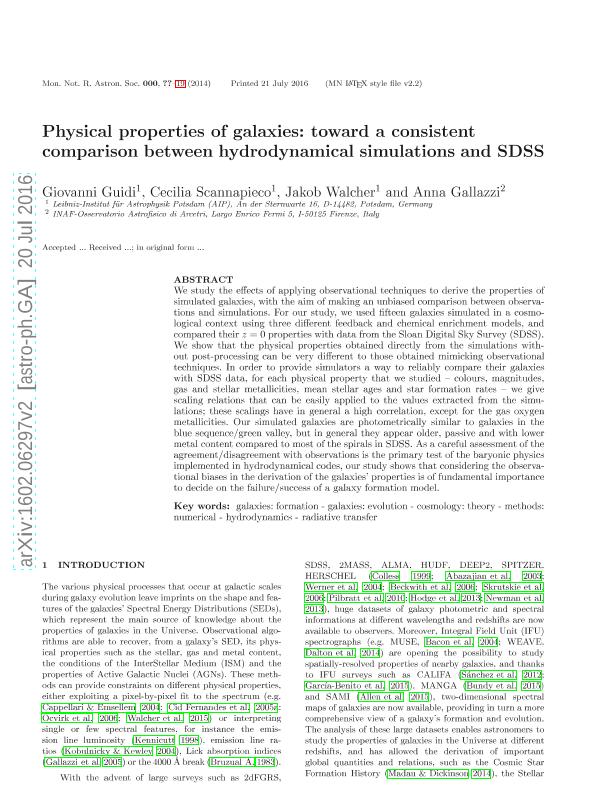Mostrar el registro sencillo del ítem
dc.contributor.author
Guidi, Giovanni
dc.contributor.author
Scannapieco, Cecilia

dc.contributor.author
Walcher, Jakob
dc.contributor.author
Gallazzi, Anna
dc.date.available
2018-09-14T19:15:08Z
dc.date.issued
2016-10
dc.identifier.citation
Guidi, Giovanni; Scannapieco, Cecilia; Walcher, Jakob; Gallazzi, Anna; Physical properties of galaxies: Towards a consistent comparison between hydrodynamical simulations and SDSS; Oxford University Press; Monthly Notices of the Royal Astronomical Society; 462; 2; 10-2016; 2046-2062
dc.identifier.issn
0035-8711
dc.identifier.uri
http://hdl.handle.net/11336/59769
dc.description.abstract
We study the effects of applying observational techniques to derive the properties of simulated galaxies, with the aim of making an unbiased comparison between observations and simulations. For our study, we used 15 galaxies simulated in a cosmological context using three different feedback and chemical enrichment models, and compared their z = 0 properties with data from the Sloan Digital Sky Survey (SDSS). We show that the physical properties obtained directly from the simulations without post-processing can be very different from those obtained mimicking observational techniques. In order to provide simulators a way to reliably compare their galaxies with SDSS data, for each physical property that we studied - colours, magnitudes, gas and stellar metallicities, mean stellar ages and star formation rates - we give scaling relations that can be easily applied to the values extracted from the simulations; these scalings have in general a high correlation, except for the gas oxygen metallicities. Our simulated galaxies are photometrically similar to galaxies in the blue sequence/green valley, but in general they appear older, passive and with lower metal content compared to most of the spirals in SDSS. As a careful assessment of the agreement/disagreement with observations is the primary test of the baryonic physics implemented in hydrodynamical codes, our study shows that considering the observational biases in the derivation of the galaxies' properties is of fundamental importance to decide on the failure/success of a galaxy formation model.
dc.format
application/pdf
dc.language.iso
eng
dc.publisher
Oxford University Press

dc.rights
info:eu-repo/semantics/openAccess
dc.rights.uri
https://creativecommons.org/licenses/by-nc-sa/2.5/ar/
dc.subject
Cosmology: Theory
dc.subject
Galaxies: Evolution
dc.subject
Galaxies: Formation
dc.subject
Hydrodynamics
dc.subject
Methods: Numerical
dc.subject
Radiative Transfer
dc.subject.classification
Astronomía

dc.subject.classification
Ciencias Físicas

dc.subject.classification
CIENCIAS NATURALES Y EXACTAS

dc.title
Physical properties of galaxies: Towards a consistent comparison between hydrodynamical simulations and SDSS
dc.type
info:eu-repo/semantics/article
dc.type
info:ar-repo/semantics/artículo
dc.type
info:eu-repo/semantics/publishedVersion
dc.date.updated
2018-09-14T14:27:22Z
dc.journal.volume
462
dc.journal.number
2
dc.journal.pagination
2046-2062
dc.journal.pais
Reino Unido

dc.journal.ciudad
Oxford
dc.description.fil
Fil: Guidi, Giovanni. Leibniz-Institut für Astrophysik Potsdam; Alemania
dc.description.fil
Fil: Scannapieco, Cecilia. Leibniz-Institut für Astrophysik Potsdam; Alemania. Consejo Nacional de Investigaciones Científicas y Técnicas; Argentina
dc.description.fil
Fil: Walcher, Jakob. Leibniz-Institut für Astrophysik Potsdam; Alemania
dc.description.fil
Fil: Gallazzi, Anna. Osservatorio Astrofisico di Arcetri; Italia
dc.journal.title
Monthly Notices of the Royal Astronomical Society

dc.relation.alternativeid
info:eu-repo/semantics/altIdentifier/doi/http://dx.doi.org/10.1093/mnras/stw1790
dc.relation.alternativeid
info:eu-repo/semantics/altIdentifier/url/https://academic.oup.com/mnras/article-abstract/462/2/2046/2589935
dc.relation.alternativeid
info:eu-repo/semantics/altIdentifier/url/https://arxiv.org/abs/1602.06297
Archivos asociados
